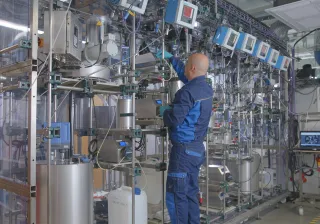VTT and Renotech Oy developed a method for the partial replacement of refractory ceramic raw material with slag from the steel industry.
Europe's steel industry produced around 21.4 million tons of slag in 2012. A quarter of this was not re-used. Slag is traditionally used in road building, for example as insulating material in the subbase of roads. The RESLAG project funded by the EU developed methods of using slag in various energy industry applications.
Finnish company Renotech Oy led one of the piloting projects under RESLAG and developed fire-resistant or refractory ceramics alongside VTT Technical Research Centre of Finland for four years. Around 5.5 million tons of refractory ceramics are made each year in Europe. It is estimated that about 70% is used by the iron and steel industry. Applications for traditional refractory ceramics include the linings of smelting furnaces in the steel industry and insulation masses in incinerators and power plant boilers.
The objective of development work in the RESLAG project was to reduce the amount of primary raw materials used to make refractory ceramics, by replacing most of them with slag-based materials from the steel industry. The mechanical and thermal properties of the castable, slag-based refractory ceramics developed were determined comprehensively at both room temperature and 1,200 degrees Celsius. This extensive data collected on properties can be used to support design, thus providing a more reliable assessment of usability across different applications.
"When you utilise steel-industry side streams, and reduce the consumption of primary raw materials and energy in production, you also reduce carbon dioxide emissions. We have now reached a level where all the aggregates used in refractors were replaced with slag-based material, and 10% of the cement needed for production could be replaced. Moreover, the slag fraction used now was fine material, the utilisation of which has been challenging so far. This was an excellent result when compared to what has been published on the subject around the world", says Senior Scientist Pertti Lintunen from VTT.
As a result of the piloting, Renotech manufactured test components based on the composition developed in the project. The components were then installed for test use in two different industrial environments. In Finland, the application was protecting a concrete structure from hot, molten splashes with a cast refractory element. Bricks were also delivered to Spain and installed in a furnace in June 2019 to evaluate their temperature resistance in long-term use. "Based on the properties achieved during the project and the test piece properties measured from the test components, there should be no surprises ahead in terms of resistance", says Renotech CEO Bob Talling.
The RESLAG project lasted almost 4 years (1 September 2015–31 July 2019) and involved a total of 19 partners from Europe and Morocco.





